The Political Economy of Abu Dhabi's Pursuits in Renewable Energy
Jim Krane
Judge Business School, University of Cambridge
(07/27/2012)
1. Abstract
Since it was announced in 2009, Abu Dhabi's plan to use renewable energy sources for at least 7% of its electricity generation capacity in 2020 has proven to be a challenging undertaking. By that year, a 7% installation will require around 1.5 gigawatts of generation capacity, most of which is expected to comprise solar generation technology, with a small component given over to wind energy. This renewables capacity would be of similar size to the 2010 solar installation in the United States. [1]
Solar-generated electricity carries costs running three to six times as high as the emirate's current natural gas-dominated power supply[2] and slightly higher than estimates for its future supply of nuclear power [3] . Scrutiny of local conditions has led to the discovery that, despite ample supply of solar energy, environmental conditions impede the effectiveness of the two main solar technologies, raising costs further. However, installation of photovoltaic solar generation appears to make economic sense as a fuel-saving alternative during summer daytime peak times, when expensive feedstocks such as diesel fuel are required to meet Abu Dhabi's power demand. In certain areas, local conditions for wind power may make it competitive with PV solar, and potentially useful as a fuel-saver as well.
Abu Dhabi's public embrace of renewables also carries political benefits that add to its attractiveness for the regime. These investments have increased the ruling family's international prestige as a developing world leader in low-carbon energy. This increased prestige translates into enhanced domestic legitimacy, a valuable resource for a rentier tribal-autocratic regime. To sum up, renewable energy provides political benefits for the regime but will be of marginal importance in covering Abu Dhabi's fast-growing electricity demand.
2. Introduction
In January 2009, the government of Abu Dhabi, one of seven semi-autonomous sheikhdoms that form the United Arab Emirates (UAE), made a remarkable announcement: By 2020, renewable energy sources would account for at least 7% of its total electric power generation capacity[4].
The full goal goes beyond this. The emirate is pursuing an "aspirational target" of 30% of its electricity capacity from low-carbon sources, including nuclear generation, with a least 7% of that total to be met by renewable energy. Through these ventures, the government aims to reduce Abu Dhabi's carbon dioxide emissions by 30 million tons per year.
Abu Dhabi is the largest and wealthiest of the seven UAE sheikhdoms. It controls 94% of the UAE's oil reserves and more than 90% of its natural gas reserves,[5] which, in turn, form 7.8% and 3.5%, respectively, of proven global reserves.[6] Abu Dhabi's 1.8 million inhabitants live in a desert emirate the size of Ireland that, as part of the UAE and a key member of OPEC, are associated with the world's largest per-capita ecological footprint[7] and, until recently, an obstructionist role in global climate change talks.[8]
Abu Dhabi energy officials have said most of its renewable energy goal will be met with solar-generated electricity, which will be funded by an overall $15 billion investment on alternative (non-nuclear) energy-related business.[9] Authorities have set up demonstration projects of the two main solar technologies, photovoltaic (PV), which converts sunlight to electricity using semiconductors; and concentrating solar power (CSP), which uses fields of mirrors to concentrate solar energy and generate heat to drive a turbine. Testing has helped establish the technology's performance limitations in a sunny but difficult environment, with extreme heat, little available fresh water, frequent sandstorms and high coastal humidity. In 2011, energy officials also began exploring development of wind power generation after efforts to develop geothermal power sources failed.[10]
In global terms, 7% is a modest amount. In 2007, Austria produced 55% of its electricity from renewable sources, mainly hydroelectric, and Denmark produced 27%, mainly from wind.[11] But the 7% target appears more ambitious when measured against low levels of clean energy investment in the developing world - especially the Middle East - and given the fact that, under the UN's Framework Convention on Climate Change, the UAE is under no obligation to reduce its emissions.
Further, alternative energy ventures offer unique challenges for rentier economies dependent on oil exports, such as those of Abu Dhabi and the UAE, or indeed of the other five hydrocarbon-exporting states in the Gulf Cooperation Council (GCC): Saudi Arabia, Oman, Kuwait, Qatar and Bahrain. Like its neighbors, Abu Dhabi faces a pressing need to reform its domestic energy policy, including a subsidy regime that has exacerbated electricity consumption and turned the country into the world's second-largest power consumer and carbon emitter, per capita.[12] But Abu Dhabi faces constraints in making energy policy reforms. Its domestic political environment favors meeting demand without serious conservation measures. And the economic environment, for the time being, still favors fossil fuel generation.[13]
Therefore, this paper will describe the challenges to Abu Dhabi's renewable energy goal and the difficult policy environment that is shaping energy planning in the region, including a shortage of natural gas and rising energy consumption. It then examines the investments needed to meet Abu Dhabi's ambitious target. It takes a closer look at the likely shape of a renewable installation, discussing costs and benefits for the state. Finally, it offers policy suggestions aimed at bringing the goal to fruition.
3. Context: challenges, advantages, policy drivers
Consumption challenges
Abu Dhabi's renewable energy venture comes amid a period of intense economic growth that saw the country diversify its decades-old role as a rentier exporter of hydrocarbons. The UAE emerged as one of the fastest-growing states in the world, in terms of population and economy, as well as electricity consumption. An economic boom that started in 2002 brought GDP growth reaching 12% in 2003 before it ended in recession in 2009, with modest growth returning since 2010.[14] Amid rising oil revenues, the UAE saw expansion in shipping and logistics, tourism, real estate and banking, as well as huge changes to the landscape and population. Leading the growth was the UAE's largest city, Dubai, which doubled in population to reach 2 million inhabitants (95% of whom were non-citizens[15] ) and quadrupled in area to reach a size of 1,450 square kilometers, nearly the size of Houston. [16]
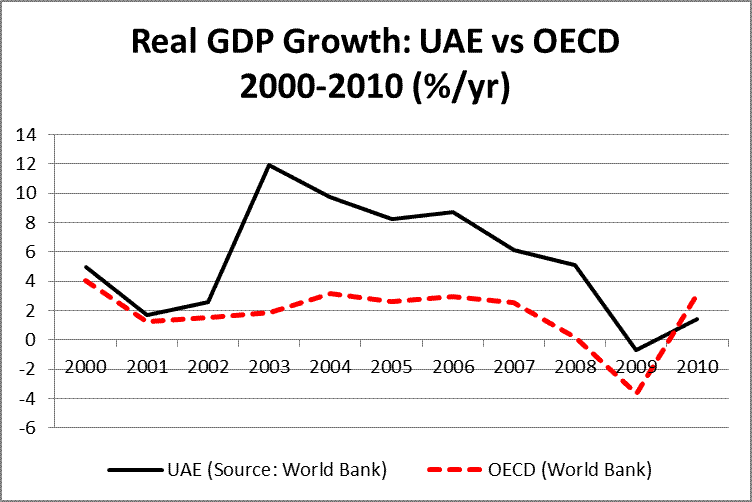
The UAE emerged from recession in 2010 on the back of Abu Dhabi's oil exports, with GDP growth of 3.3% in 2011 and growth of 3.5% forecast in 2012 [17] . The population of Abu Dhabi city (as opposed to the rest of the emirate) is expected to double from about 1 million inhabitants in 2009 to 2 million by 2020 [18] while the population of UAE as a whole is expected to grow from 6.7 million in 2010 to 8.2 million by 2013. [19]
Growth in electricity consumption has outpaced that of population and GDP, however. In the two decades between 1991 and 2010, electricity generation in the UAE more than quintupled, rising from 17.4 terawatt-hours (tWh) to reach 88.6 tWh, an average growth rate of nearly 8.5 % per year. [20] That rate is higher than that of the rest of the GCC, but lower than electricity generation growth in boomtime Japan, South Korea and China (see table).
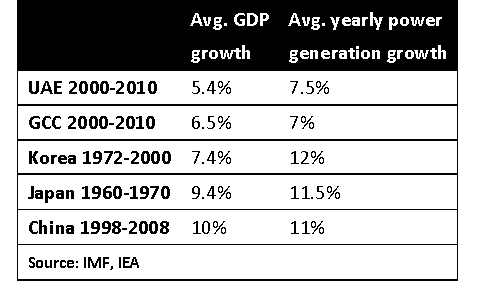
In 2011, Abu Dhabi held the lion's share - 13.8 gigawatts (GW) of the UAE's nearly 25 GW in generating capacity (see table).
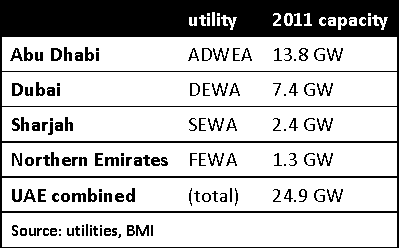
Going forward, Abu Dhabi's current installed base of 13.8 GW is forecast to reach 23 GW by 2020 and expand to 43 GW by 2030. [21] Peak power consumption in Abu Dhabi is expected to grow by one of the fastest rates in the world - more than 11% a year - until 2015, slowing to 9.4% to 2020. [22] (The chart below forecasts growth of Abu Dhabi's peak power demand, but does not include a projection for installed capacity. Installed capacity is maintained at roughly 10% above peak demand, thus 43 GW. [23] )

Behind those startling figures is yet another: In 2006, the emirate's utilities regulator found that Abu Dhabi residents consumed a yearly average of 41,000 kilowatt-hours (kWh) of electricity, [24] nearly quadruple the average American's consumption in 2008 of 11,000 kWh. [25] Electricity use was a big factor in pushing the UAE's per capita greenhouse gas emissions to the world's No. 2 position (behind Qatar). [26] UAE residents have also been recognized as the holders of the world's largest ecological footprint, 57% of which is attributable to residential electricity consumption. [27] The following charts illustrate the magnitude of the UAE's growth in electricity generation and carbon dioxide emissions by comparison with similar-sized Switzerland.
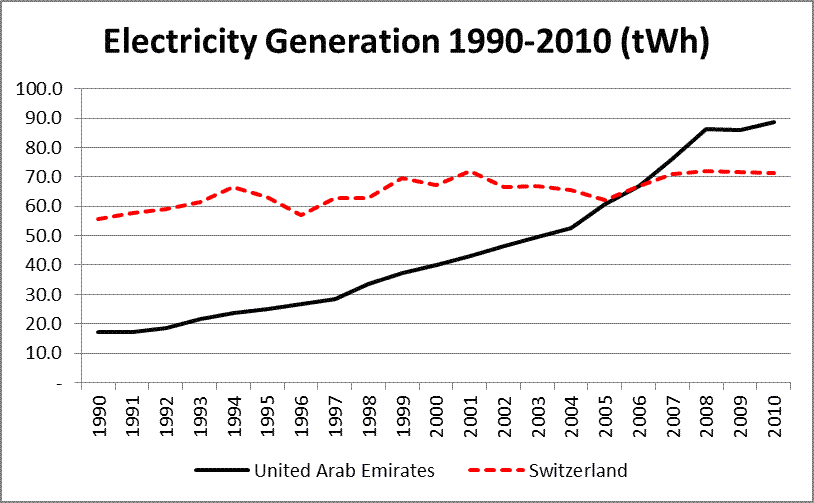
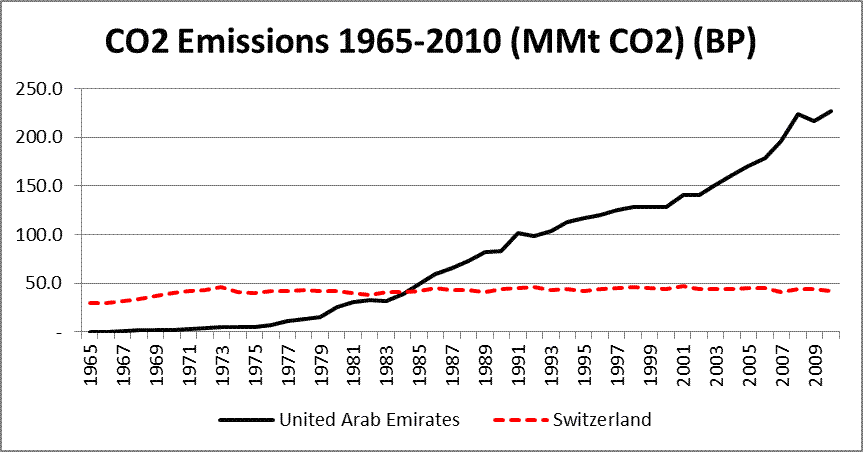
Abu Dhabi's renewables capacity, now around 10MW, must grow at a rate of more than 150MW per year if it is to reach 7% of capacity by 2020. Thereafter, renewables must expand alongside increases in overall capacity to avoid slipping below the 7% threshold. That means Abu Dhabi must aim for roughly 1,500MW (or 1.5 GW) by 2020 which is more than 13% of current capacity, a figure that compares more favorably with renewables installations in the developed world. By 2030, the renewables capacity will have to grow beyond 2,300MW to remain above the target threshold. Note that Abu Dhabi's goal is not to generate 7% of its electricity with renewables, but to use them for 7% of the emirate's "installed capacity." Given the capacity factor of solar electricity, which is generally below 25% - compared with roughly 80% for a baseload combined-cycle gas turbine (CCGT) plant - a 1.5 GW installation of PV solar electricity would provide about 2.5% of Abu Dhabi's overall power. [28]
Economic and technical challenges
Development of renewable electricity in Abu Dhabi, as in the rest of the GCC, has been constrained by its inability to compete on a cost basis with subsidized thermal generation.
[29]
In the UAE with its enormous hydrocarbon reserves, the government has long relied on cheap sources of natural gas feedstock. Natural gas provided to utilities is underpriced by the government, and the electricity generated has traditionally been given a further subsidy when sold to customers.
Abu Dhabi provides its electricity generating plants with gas at around $1-$2 per million British thermal units, which is the rough equivalent of selling oil at $6-$12 per barrel when world market prices are beyond $100.
[30]
This underpricing allows utilities to produce, transmit and distribute electricity for about 5 or 6 U.S. cents per kWh
[31]
, about half the average U.S. retail price of 11 cents. Among residential customers in Abu Dhabi, citizens pay 1.4 U.S. cents per kWh,
[32]
which implies a total subsidy of around 8.5 cents per kWh,
[33]
while non-citizens pay 4 cents per kWh, receiving a subsidy of 6 cents (See subsidy chart in Annex). This provision of inexpensive electricity is a key component of the rentier state social contract between rulers and citizens, which trades subsidized lifestyle comforts for political support.
[34]
It is also a key component of inefficient consumption that lies behind the shortages of natural gas and electricity in Abu Dhabi and elsewhere in the GCC.
[35]
At first glance, it would seem to make little sense for Abu Dhabi to bring solar power into this "cheap energy" landscape, where fast-growing and wasteful consumption would appear to call for continued installation of less costly generating capacity. Solar power requires large up-front investment that contributes to levelized electricity generation costs of around 33 cents per kWh for CSP [36] and 15.4 cents per kWh for PV. [37] Photovoltaic panels have grown cheaper in recent years, with prices dropping by 20% for each doubling of global production capacity, [38] which works out to as much as 7% per year. [39] Still, given the cost advantages of gas-generated power and the government's willingness to subsidize it, Abu Dhabi's renewable electricity venture is a comparatively costly investment. It will contribute to a more distorted subsidy environment if electricity prices remain fixed, as the government has suggested, without a parallel move toward cost-reflective tariffs. (The CSP cost chart in this paper's Annex suggests a government subsidy of 31 US cents per kWh would be needed to maintain citizens' current residential tariffs.) Abu Dhabi's electricity regulator has indicated that the government will increase its subsidy outlays so that residential tariffs, at least, are not affected by the onset of renewable power. [40]
Other factors weigh against solar energy in the UAE. The typical summer electricity demand curve for a Persian Gulf city reveals two daily peaks. The first peak comes at midday, when the sun is overhead. The second peak comes after sundown in the early evening, when Gulf humidity effects are at their most intense. Solar radiance is well matched to the first peak, but not the second. [41] Therefore, Abu Dhabi would not be able to build solar power capacity in lieu of conventional generation capacity, making it unable to forgo the cost of building, operating and maintaining a conventional power plant. Solar power would merely allow the emirate to reduce its fuel consumption. Further, PV solar faces losses of at least 10% [42] and CSP faces a loss of up to 20% [43] of effectiveness in the heat, dust and humidity that prevails in the region. [44] A UAE-based solar energy executive estimated that a UAE solar plant would have to be twice as big as a similar capacity plant built amid more favorable conditions in India and elsewhere in the Middle East. [45]
In addition, solar power usually requires water to keep solar panels or reflectors clean and, with CSP, to cool generating turbines. In Abu Dhabi, water will have to be desalinated and piped to the site at significant cost. Such issues have caused persistent delays on Abu Dhabi's construction plans for solar electricity plants. [46]
Geographic advantages and challenges
But Abu Dhabi also has key advantages that increase the likelihood of attaining of its 7% goal. The first is geography: Most of Abu Dhabi's 67,000 sq km consists of open, uninhabited desert and salt flats that receive at least 2,000 kWh of solar energy per square meter, per year. [47] These are advantageous characteristics for large-scale solar energy installations. By comparison, Germany, which held the world's largest PV market in 2008, [48] receives less than 1,500 kWh m2/yr. [49]
Cambridge University physicist David MacKay, chief scientific adviser to the UK Department of Energy and Climate Change, estimated that the UAE has 2,000 terawatt hours per year in CSP generating potential on its land, which, if it were covered with mirrored panels, could produce 125 kWh of electricity per day (the UK per-capita standard) for 43 million people. [50] About half of that land is open land in Abu Dhabi, so roughly halving the land area and doubling the consumption standard for the energy-hungry Gulf would be appropriate: 250 kWh/day for 11 million people. Of course, such calculations do not consider local conditions or the practicalities of covering much of the landscape with CSP.
Abu Dhabi's geographic advantages did not initially appear to extend to wind energy potential. Early assessments of the UAE's average wind speed ranged from 2.5 to 4.5 meters per second [51] with pockets slightly beyond 5 m/sec, [52] which allows for generating potential estimated at just 1,176 hours of full load per year, the lowest level of any of the six GCC countries. [53] An 850 kilowatt-capacity wind turbine installed on Sir Bani Yas Island in 2008 receives average wind speeds at turbine level of just over 5 m/sec, [54] among the lowest of any offshore wind turbine in the world. [55] By contrast, average wind speeds at UK offshore turbines in the North Sea run over 10 m/sec. [56] The capacity factor of the Sir Bani Yas turbine, at under 15%, is also well below the typical 20-40% for offshore wind. [57] Despite this, Abu Dhabi officials in 2011 vowed to press ahead with 20-30 MW of further wind development on Sir Bani Yas Island. However, recent measurements have found higher wind speeds, and the wind speed assessments mentioned above will probably have to be adjusted. For example, researchers assessing a site for a PV solar park near the inland city of Al Ain, on the Omani border, found higher-than-expected wind speeds averaging around 6m/sec. This discovery and the difficulties encountered with solar installations make a significant wind installation likely, an Abu Dhabi utility official said in 2012. [58] The intermittent nature of wind energy, however, also renders it inappropriate for replacing capital investment in consistently dispatchable sources of power needed to meet peak electricity demand. Wind power, like intermittent PV solar, is best considered a fuel-saving option in the Gulf environment, rather than a capacity addition. [59]
Masdar: Developing expertise
Abu Dhabi's rulers, especially its crown prince, Sheikh Mohammed bin Zayed al-Nahyan, have taken a proactive approach to the international climate change agenda, seizing it as a commercial opportunity and breaking with the OPEC line of treating carbon reduction as a threat to hydrocarbon exports. The biggest manifestation of this strategy is the Abu Dhabi Future Energy Co., also known as Masdar ("source" in Arabic), which aims to put Abu Dhabi into the clean energy forefront while creating jobs and diversifying the oil-driven economy.
Masdar was unveiled in 2006 amid announcements of $15 billion in government funding for its business unit and sundry clean energy projects. Masdar's various arms were to include a zero-carbon-emitting city for 40,000 residents and 1,500 businesses; a carbon management unit, a clean technology investment fund, and a graduate school affiliated with the Massachusetts Institute of Technology. Masdar CEO Sultan Ahmed al-Jaber said in 2007 that Masdar enjoyed "an unlimited budget for renewable energy projects." [60] This exuberance was short-lived. Masdar's ambitions were scaled back after the 2009 recession, and several projects were cancelled or downsized. Among the victims was Masdar City itself, which saw its zero-carbon promise dropped as too expensive. The city's size was reduced and completion date pushed back. As of 2011, Masdar City consisted of a few modern buildings, including a raised plaza housing the MIT-affiliated graduate school and living quarters, with a few other buildings under construction. Another shelved clean energy project was a 400 MW hydrogen power plant that was to have been built as a joint venture with BP. [61]
Wealth and autocratic rule
Abu Dhabi is often described as the richest city in the world. [62] In 2010, the emirate produced a per capita GDP of $86,000, representing more than 60% of the UAE's overall economy. Were it a nation-state, its residents would take the third-wealthiest position, ahead of Luxembourg, Singapore and Norway but behind Liechtenstein and Qatar. [63] The holdings of Abu Dhabi's sovereign wealth fund are estimated in the hundreds of billions of U.S. dollars.
Abu Dhabi is run as a tribal autocracy, the only form of government it has ever known. Its ruler, Sheikh Khalifa bin Zayed al-Nahyan, who is also the UAE president, enjoys broad autonomy on policy and financial matters. Petroleum rents dominate the economy, funding the government and allowing it to distribute lucrative benefits and services without levying income taxes. The relatively small population of UAE citizens, around 200,000 in Abu Dhabi among 1 million in the UAE overall, tend to support the ruling family and make few demands for political participation. This rentier social contract, or "ruling bargain," is a staple of the academic literature on economies dominated by resource exports, including the GCC states. [64] In short, Abu Dhabi's rulers have the money and the authority to pursue renewables without having to rationalize investments on a political or competitive commercial basis.
But regime autonomy does not allow rulers free rein to tinker with the social contract that underpins their legitimacy. The rentier state literature declares that rulers have little margin for targeting electricity demand by eliminating subsidies and raising prices. [65] Rentierism also prevents society from responding to the consumption problem, because it damages society's organizational capacities, stifling the type of grassroots movements that might decry the waste of resources, and rewarding individual rent-seeking behavior. [66] Rentierism, writes Hertog (2010), rewards profligacy and corruption and contributes to "slack and waste." [67] Thus regimes in Abu Dhabi and the rest of the Gulf, with an eye to self-preservation, have opted for boosting energy supply. Efforts to confront demand have been weak: mainly public campaigns, building code modifications, and minimum standards for appliance efficiency. Among all the Persian Gulf monarchies, only Dubai has been willing to raise utility prices on citizens. [68]
Policy drivers
What is driving Abu Dhabi's renewables target? Why would one of the world's most energy-endowed regions commit itself to adopting intermittent, low-density and expensive renewable generation when it can pursue cheaper and more efficient means? Luomi (2009) writes that Abu Dhabi's alternative energy projects have three chief functions: economic diversification, domestic energy security, and increasing the ruling al-Nahyan family's political legitimacy so that it might maintain control beyond the oil era. [69] Viewed in this light, these alternative energy pursuits can be considered part of the same group of rentier "monarchical survival strategies" that Davidson (2009) describes, and which he blames for creating many of the internal structural failings, including the energy debacle, that now confront the regime. [70]
Energy security: The gas shortage
Despite holding the world's fifth-largest gas reserves, some 6.4 trillion cubic meters [71] , the country - Abu Dhabi included - has developed a paradoxical shortage of natural gas feedstock used in electricity generation. With gas demand rising nearly 6% a year for the past 20 years, by 2008 the UAE had become a net importer of natural gas. In 2010, the UAE imported 17.41 billion cubic meters of gas, mainly via pipeline from nearby Qatar. [72] (see chart below) A similar shortage affects four of the UAE's five GCC neighbors. Only Qatar has sufficient gas for domestic needs. [73]
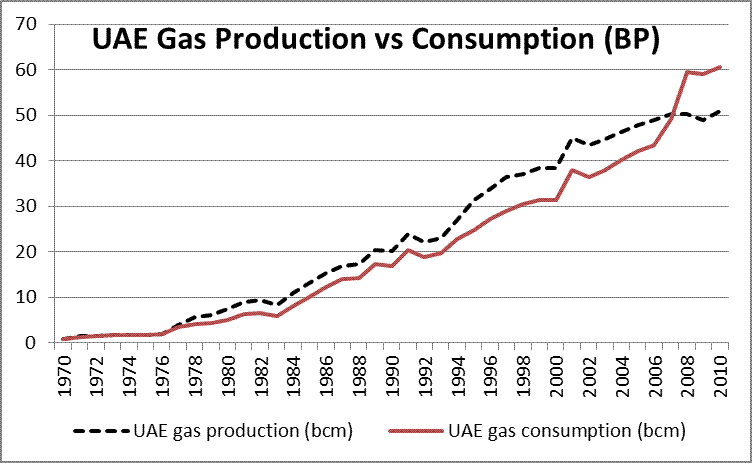
The gas crunch has several causes. First is price: As mentioned, gas sold domestically is underpriced, which increases demand and discourages upstream investment, since the costs of exploration and production cannot be recouped through domestic gas sales. Second is the array of consumers: Abu Dhabi's gas is used in industry, for re-injection into oil reservoirs to maintain production, and is tied to long-term export contracts that saw 7.9 billion cubic meters of liquefied natural gas (LNG) shipped to Asia in 2010. [74] A third factor is that most reserves are of associated gas and therefore extracted in tandem with crude oil, production of which is restricted by OPEC quota. A fourth factor is that a large portion of Abu Dhabi's untapped unassociated gas reserves are of highly sulfuric "sour" gas that have proven frustratingly difficult to produce. In April 2010, a $10 billion sour gas production plan was delayed when chief contractor ConocoPhillips pulled out of its agreement to develop the field. But a chief driver of the gas shortage, and the factor that concerns this paper, is domestic consumption of electricity.
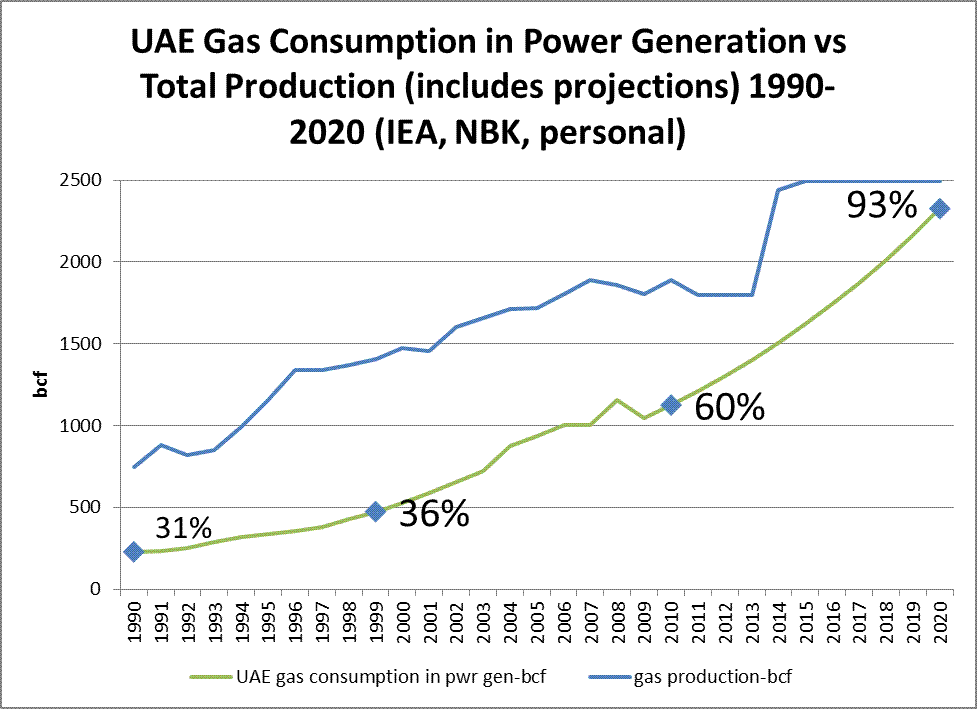
As the accompanying chart shows, if UAE utilities continue consuming natural gas at the present rate, the electricity sector alone would require 93% of the UAE's indigenous production by 2020. This projection does not encompass gas demand for enhanced oil recovery, industry, petrochemicals or any other use beside power generation.
In short, Abu Dhabi's supply of inexpensive domestic natural gas appears to have reached its ceiling. Additional gas for power generation or other use will either have to be produced from more expensive domestic sources, at prices roughly five times the current sale price of bulk gas to power producers, or imported. Qatar, which supplies 2 billion standard cubic feet per day of discounted natural gas to the UAE via the undersea Dolphin Pipeline (around $1.30 per million Btu [75] ) has indicated that it is unwilling to increase exports at discounted prices. Energy officials in Qatar interviewed for this paper have said that, provided Qatar's ongoing moratorium on additional gas production is lifted after 2014, additional supplies will only be made available to GCC customers at world market prices. Thus, Abu Dhabi's electricity consumption has begun to compete with other uses for gas, amid a regional trend of increasing scarcity of natural gas.
Given the constraints on gas availability and the increasing costs associated with continued increases in consumption, the diversification of Abu Dhabi's electricity generation technologies makes sense. Policymakers in Abu Dhabi see development of nuclear and renewable electricity as a strategy to prolong the life and maximize the value of hydrocarbon reserves, while reducing reliance on a single energy source. [76]
Energy security: Supply diversification
Another impetus for renewables is that rising demand appears likely to outpace the construction timetable of Abu Dhabi's major alternative energy investment, nuclear power. In December 2009, Abu Dhabi announced it had accepted the $20.4 billion bid of a South Korean consortium to build four 1.4 GW nuclear power stations. Plans call for completion of the first reactor in 2017, but some observers do not expect the power to be available before 2019, given the normal 10-year planning, design and building timeline for nuclear plants. [77]
Supply of natural gas, via domestic production and pipeline import, was already falling short of demand for power generation feedstock in 2010, years before Abu Dhabi's nuclear power plants come on-stream. The supply gap in 2010 and 2011 was filled by burning expensive domestic diesel fuel. [78] Abu Dhabi's options for closing this feedstock gap appeared to comprise the following means:
- through politically difficult reductions in demand;
- by producing from new sources of domestic gas;
- by re-routing domestic gas destined for reinjection for enhanced oil recovery (EOR), or other use;
- by burning liquid fuels such as diesel or crude oil;
- by importing LNG;
- by diversifying generating technologies into coal or renewables.
At the time of writing, policymakers had chosen to reduce reinjection for EOR and Abu Dhabi National Oil Co., or ADNOC, was ordered to re-route sufficient domestic gas to the power sector, at least through the end of 2012. [79] New domestic sources of gas are also under development, but will not be enough on their own to cover demand. [80] For political and environmental reasons, coal is unlikely to gain traction in Abu Dhabi. [81] Abu Dhabi does burn diesel fuel and crude oil in times of peak demand when gas is insufficient to meet demand, but this is a costly practice. In 2011, the emirate's utilities consumed 17.6 per million British thermal units (MMBtu) of refined diesel [82] , amounting to 3% of its feedstock but comprising 25% of its fuel costs. [83]
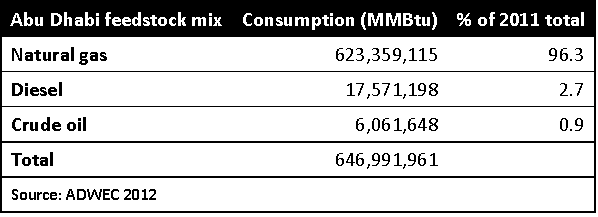
Domestic crude oil is also burned in times of peak demand, but burning it implies an opportunity cost of around $17 MMBtu in lost export revenue, with oil at $100/barrel. Burning domestic diesel fuel has an even higher opportunity cost, around $22 MMBtu at the time of writing. Liquid fuel consumption also implies higher emissions and faster depletion of the chief source of national income. Imported LNG is another option that appears to be gaining favor in Abu Dhabi. LNG would be slightly cheaper (at March 2012 prices) than diesel, with Kuwait paying $15 MMBtu for its LNG cargoes in 2011 [84] , although an Abu Dhabi utility official said in 2012 that the emirate would be able to source LNG at lower prices than its neighbors. [85]
In this environment, solar energy (as well as nuclear power) is an increasingly attractive option. Mills (2012) has written that large-scale PV solar plants in Gulf conditions could produce electricity at a levelized cost of 15.4 U.S. cents per kWh, which is competitive with CCGTs burning LNG priced above $13 MMBtu or with liquid fuels with oil prices above $80 per barrel. [86]
Economic diversification
The oft-cited rationale for investment in renewables - the idea that a new economic sector can be created - is best described in the GCC as a long-term bet. GCC officials, including the Saudi energy minister Ali al-Naimi, have spoken of hopes that exports of solar-generated electricity can maintain the region's status as global energy supplier beyond the oil era. [87] Other proponents have mentioned that big enough deployments of alternative energy could free up gas and oil for use in higher-value exports. Abu Dhabi is already using its renewables initiative to attract foreign investment and transfers of technology. The aim is to create a high-skill economic sector that can achieve social as well as financial returns. [88] And, perhaps less speculatively, renewable projects could generate external rents by participation in the UN’s Clean Development Mechanism carbon credits program. [89]
International and national prestige
In 2009, Abu Dhabi was granted the unique honor of hosting a UN agency, the International Renewable Energy Agency (IRENA), the first global organization headquartered in the Middle East. Abu Dhabi beat out front-runner Germany - despite the UAE's dismal environmental record - using intense diplomacy and promises of $135 million in support, including a carbon-free headquarters in Masdar City. [90] The prestige-enhancing presence of IRENA adds significant pressure on Abu Dhabi to reach its 7% renewable electricity target. In fact, one UAE-based energy analyst interviewed for this paper suggested that IRENA's continued presence in the city hinged on Abu Dhabi's meeting its goal using uncontroversial sources of renewable power - i.e., not stretching the definition to include hydrogen or nuclear power - and avoiding emissions-rich coal-fired generation. [91] With 1.5GW of solar power, Abu Dhabi (and the UAE) would, by today's global rankings, sit in fourth or fifth place. In 2010, Germany had more than 8GW of installed capacity; Spain around 3.5GW; Japan over 2GW; and Italy and the United States more than 1GW apiece. [92]
Luomi (2009) writes that IRENA's presence implies a commitment of the emirate's fossil fuel revenues toward renewables. [93] In return, the ruling sheikhs receive international prominence that sends an important signal to the domestic audience. Recognition as an effective handler of foreign affairs is, alongside government handouts, a key pillar of public support for rentier autocrats. [94] Likewise, the lauded Masdar initiative demonstrates that an oil-producing state can make an important contribution toward climate change goals despite the fact that the UAE, as a developing country, is not required to do so under the UN Climate Convention. Abu Dhabi's actions are held out as a model for the region. [95] Such prestige enhancements increase the attractiveness of renewables, despite the weak economic case for investment.
4. A description of a future renewable energy sector in Abu Dhabi
In his book Sustainable Energy - Without the Hot Air, MacKay outlines a CSP development in the Sahara of scattered 1,500-sq-km plots, each of which would produce 10GW for the European market. Half the land on these London-sized parcels would be given over to CSP mirror arrays and related equipment, and the other half to agriculture, railways and homes. [96] Conditions in the Arabian Desert in Abu Dhabi are similar to those in the Sahara. Extrapolating from MacKay's plan, Abu Dhabi would need a 225 sq km tract for a CSP generation node that could produce 1.5 GW, the amount needed to reach its 7% goal. One-half of that area - 115 sq km - would be covered in mirrors, towers and power plants. (The figure below illustrates the size of such a plant.) That works out to 13MW per sq km. Using MacKay's estimates, the development would cost something like $19 billon, or nearly $13 billion per gigawatt. Abu Dhabi's 2010 CSP contract (see next section) decried as expensive, implies a much lower per-GW cost near $7 billion, and a better power-to-area ratio of 40MW/sq km.
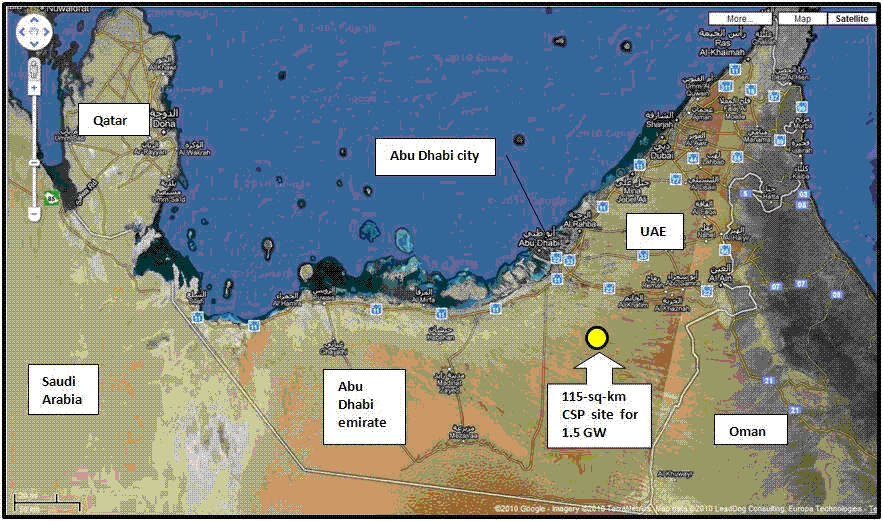
MacKay's CSP vision appears unlikely in the UAE. In nearly three years of testing and data-gathering since the 7% announcement in 2009, a more accurate picture of the UAE's solar and wind resources has emerged, along with a greater understanding of the environmental and atmospheric conditions affecting those resources. As understanding has grown, electricity sector officials in Abu Dhabi have altered their estimates of the makeup of the emirate's renewables installation, from a CSP-dominated one, to a technology mix with more photovoltaic solar and wind power. A chief driver for the shifting priorities has been disappointment with the expected performance of the Shams I CSP project.
The Shams CSP development was to have generated about 20% of Abu Dhabi's renewables target, or 300 MW, in three phases. But after numerous delays, Abu Dhabi awarded in June 2010 a $700 million contract for construction and operation of Shams I, the initial 100 MW plant. Construction of Shams I in western Abu Dhabi was nearly finished at the time of writing, handled by a joint venture headed by Masdar and including Spanish solar company Abengoa, and Total, the French state energy firm. [97] The initial phase has covered 2.5 sq km of desert with mirrored parabolic troughs, which reflect direct solar radiation onto a receiver that drives a generating turbine. [98] The plant will employ various modifications to cope with the dust and unavailability of water, including more frequent cleaning of mirrors than in plants elsewhere, and a turbine that is cooled by air, rather than water. [99]
Shams I is expected to begin producing electricity by fall 2012, however its electricity production will be degraded by low direct solar radiation caused by airborne humidity and dust at the site, near Madinat Zayed in Abu Dhabi's western interior. Shams I also lacks an electricity storage component, so that it will be unable to dispatch solar power for Abu Dhabi's peak evening period. An Abu Dhabi utility official said in March 2012 that the lack of storage has rendered Shams I a very expensive and low-tech project, and that, if the next two phases (Shams II and III) are built, they will probably be relocated to more favorable sites. [100]
As CSP's viability appears to have dimmed, that of wind has grown. In March 2012, an official with the Abu Dhabi Water and Electricity Authority said that solar power site exploration had turned up surprising amounts of wind power in inland areas near the Omani border and along the Indian Ocean coast, where consistent average wind speeds of near 6km/sec had been observed. At that wind speed, wind turbines could produce power at a similar price to that of PV solar generation. [101] In 2011, Masdar announced it was exploring the possibility of erecting a 100 MW wind farm in the inland desert near the Saudi border, as well as further installations on Sir Bani Yas Island. [102]
While the final makeup of Abu Dhabi's renewables installation remains unclear, PV solar technology appears to be gaining favor for reasons of performance and cost, despite its inability to meet the crucial evening peak load. As mentioned, use of PV could reduce consumption of expensive liquid feedstocks during the peak summer demand period, at least during daylight hours. Masdar already operates a 10MW solar PV array on the site of its future city, and is developing plans for a 100 MW PV project titled Nour I, near the inland oasis city of Al Ain. Abu Dhabi had received numerous bids by companies wishing to erect the Nour I PV park, but had not awarded a contract as of March 2012. In September 2011, Abu Dhabi commissioned a trial project of 2.3 MW of rooftop PV panels, which it intends to form an initial part of a scheme for 500 MW of distributed rooftop PV generation. [103]
Abu Dhabi's exploration and testing of various renewables technologies was well under way at the time of writing. Officials' early indications that the emirate's installation would be CSP dominated have been amended. The final shape of the project will probably include larger components of PV solar as well as wind generation than originally envisioned. The difficulties and delays encountered in the endeavor also increase the likelihood that Abu Dhabi will miss its 7%-by-2020 deadline.
5. International cooperation
Abu Dhabi has benefited from government-to-government advice and assistance in its consideration of renewable energy technology schemes, as well as in its attempts to increase energy efficiency. In one example, the United Kingdom's Foreign and Commonwealth Office has funded a study by LondonZ-based think-tank Chatham House into developing energy intensity targets for the GCC countries, including for the UAE. The study aims to use domestic energy conservation programs to delay the onset of depletion and the inevitable constraint on hydrocarbon exports. The study seeks to develop a policy framework that allows GCC countries to meet proposed energy intensity reduction targets of 2% to 3% per year.
Officials from the U.S. Department of Energy (DoE) and Masdar signed a Memorandum of Understanding in April 2010 that aims to promote collaboration on renewable energy technology, focusing on the areas of carbon capture and storage (CCS), water and bio-fuels, and building technology. The agreement has fostered the formation of bilateral working groups, which have been exchanging information on these fields, as well as on strategies for public outreach by the clean energy sector, and investment-oriented analysis with the U.S. Advanced Research Projects Agency. A year after the signing, DoE announced it would collaborate with Masdar on a solar energy pilot project aimed at testing PV panels for resistance to moisture and dust coating that has reduced performance. The project will test anti-adhesion coatings selected by the U.S. National Renewable Energy Laboratory with the intent of improving PV performance in the Gulf environment. The PV test was announced in 2011 during a visit of U.S. Deputy Secretary of Energy Daniel Poneman to Masdar's existing PV installation. [104]
In January 2012, Masdar CEO Sultan al-Jaber and Scotland's First Minister Alex Salmond signed an agreement focusing on joint investment, technological cooperation and policymaking in the areas of wind power, CCS, low-carbon business development, and renewables research and development. Most of the efforts of this agreement appeared to be aimed at projects in Scotland, in which Masdar was encouraged to invest. Announcements detailing the agreement provided no details on projects located in Abu Dhabi. [105]
Masdar's cooperation with Japanese entities includes Masdar Capital's two clean technology funds, which are backed by the Japan Bank for International Cooperation, Japan Oil Development Co. Ltd., Nippon Oil Corporation and the Development Bank of Japan. [106] Japanese entities are also involved in a Masdar R&D effort to design a tower that can "beam down" solar energy and reduce energy losses from pumping required in ordinary CSP towers. The beam down project includes investment and support from Japan's Cosmo Oil Company and the Tokyo Institute of Technology. [107] Much of Abu Dhabi's government-to-government cooperation is focused outward, however, with Masdar investing or collaborating in renewables projects in Afghanistan, Tonga and Spain. [108]
6. Policy Needs
Abu Dhabi's economic rationale for renewables may be weak, but it is already accruing political gains from its investment. It has set a target and taken steps toward meeting it. It will need to move more decisively if it is to reach its goal by 2020, which requires the installation of an average of more than 150 MW of renewables per year. What policy instruments are needed to support the renewable sector, so that Abu Dhabi can reach its 7% target?
Other countries' experiences show that integration of renewable electricity onto national grids faces barriers, mainly in the form of incompatible regulations designed for conventional power generation. [109] Spain's renewables sector was hampered by the lack of coordination among overlapping jurisdictions, as well as by fines for deviations to scheduled production. [110] Other hurdles include lengthy authorization procedures for construction, extending grid connections, power purchase agreements, and initiating production. Regulations must be forgiving toward intermittent and somewhat unpredictable generation to prevent renewables from being handicapped by competition with hydrocarbons. [111] To make these changes, Abu Dhabi needs a coordinating body, written policy direction, and changes to utility law.
There is also the matter of price competition. In Europe, governments have encouraged more expensive renewables with guaranteed grid access and feed-in tariffs that base electricity offtake prices on generation costs, which are passed along to consumers. Under the heavily subsidized generating environment in Abu Dhabi, a portfolio standard that defines minimum inputs from energy types makes more sense. [112]
Policy recommendations
The following recommendations are aimed at creating an environment of institutional support for Abu Dhabi's renewable sector, with the goal of ensuring that renewables form at least a 7% share of the emirate's generating capacity from 2020.
- Renewable and low-carbon policies should be enshrined in a binding Renewable Energy Policy document that is implemented through the creation of a Renewable Energy and Climate Change Agency. Other governments have found these policies best implemented in a whole-government approach through a body that can manage interests and contacts with stakeholders. [113] This has been lacking in Abu Dhabi. Masdar's vision and investment drive could be coordinated and strengthened under the mandate of a government agency. [114]
- The agency could exist as a sub-ministry at the UAE federal level (upon buy-in from other emirates) or as an emirate-level agency within the Abu Dhabi bureaucracy. The new agency should be headed by an Emirati leader in the sector and mandated to take steps to meet the goals of Abu Dhabi and, potentially, those of the UAE. [115]
- Abu Dhabi's utility laws should be updated to accommodate renewable power. [116] At the time of writing, amendments were being proposed to the emirate's 1998 Law No. 2 Concerning the Regulation of the Water and Electricity Sector. Law No. 2 was designed to regulate independent water and power producers (IWPPs) who manage the emirate's mainly gas-fired power stations. It outlines a system by which the government electricity procurer, the Abu Dhabi Water and Electricity Co. (ADWEC), supplies feedstock to each IWPP and purchases all electricity generated. The code requires ADWEC to use the "economic purchase method" requiring it to buy lowest-cost power first. [117]
- The law should be updated to license renewable generators and permit purchases of their more expensive power, while allowing for intermittent energy flows. Left as is, the law prevents ADWEC from buying renewable electricity unless no cheaper sources are available. Among the changes recommended:
- Establish "portfolio standards" requiring ADWEC, with some flexibility, to prioritize purchases from renewable sources ahead of hydrocarbon-based generators. Given the variable nature of renewables, a strict percentage-based target could be impractical. [118] Energy purchase agreements should be structured to cover production costs and offer sufficient profit to encourage investment. This would be a similar arrangement to feed-in tariffs, allowing ADWEC to pay premium prices for solar electricity as well as that produced by Abu Dhabi's future nuclear development.
- Amend the Transmission Code to give renewables priority access to the grid, as the Abu Dhabi Regulation and Supervision Bureau (RSB) has already recommended. [119]
- Allow for distributed generation via small-scale and rooftop PV installations. The code should be amended to support two-way metering and two-way billing, so that PV producers can help meet peak demand by selling excess electricity to the grid while the sun shines and purchasing power from the grid at night. In the case of small distributed producers, a premium payment (feed-in tariff) could encourage investment.
- As soon as results from its renewables demonstration projects are available, Abu Dhabi must scale up its renewables capacity at a rate sufficient to reach the 7% target by the 2020 deadline. This endeavor may well allow Abu Dhabi to capture first-mover advantage in the regional clean energy industry, which could help build human capital in a new economic sector.
- The government should adopt strict conservation and renewable energy standards in its own buildings, perhaps striving for 10% renewables by 2020, as an encouraging example to residents and the private sector.
- Building codes should be amended to mandate readiness for rooftop PV installation, as was being done at the time of writing. [120]
Cost-reflective tariffs
And finally, Abu Dhabi's entry into the climate change battle should be backed by one of the most difficult reforms of all: demand-side management, including reducing electricity subsidies granted to residential customers. Renewable electricity requires significant increases in electricity costs, which, if left unaddressed, would exacerbate the distortions in the electricity market and increase the government's losses. The government has already indicated that its subsidy regime will be expanded to cover these increased costs, at least for residential customers. [121] For electricity sales in the citizen residential sector, this implies a subsidy of roughly 13 cents per kWh for PV and 31 cents per kWh for CSP, given the cost of generation between 15 and 33 U.S. cents per kWh and current residential electricity prices at under 1.5 U.S. cents. (See Annex.) The government should make the case that these increased costs must be shared by electricity customers, giving them a financial incentive to reduce consumption. A slowing of electricity demand growth, especially during peak periods, would decrease pressure on ADWEA to add new conventional generating capacity, allowing the utility space to focus on renewables.
Indeed, there is some evidence that Abu Dhabi may raise tariffs, even as the uprisings of the Arab Spring have made governments, including Abu Dhabi's, more cautious in domestic policy. Abu Dhabi's electricity regulator in 2012 released a bid proposal seeking economic advice on calculating a cost-reflective tariff for electricity and water generation, as well as a fee for wastewater disposal, which is currently provided for free. [122] And Abu Dhabi's Cabinet-like Executive Affairs Authority [123] has established a Demand-Side Management Committee [124] whose research shows that conservation could reduce the emirate's peak electricity load by 10% by 2020. [125] The government has already begun mainstreaming conservation messages to the public. [126] Authorities will have to make the case that rising living standards entail enlightened energy values. A "less is more" message could show that energy conservation is status-enhancing on a personal level, and for the UAE's international image. The campaign's goal should be to ease political barriers to raising electricity prices. [127]
A recent RSB strategy document states that cost-effective tariffs have already been approved for its biggest customers, those using more than 1 MW. [128] The regulator intends to introduce a discounted tariff for those willing to withstand disconnections during peak hours, seeking to shave 250 MW - 4% - from peak consumption by 2012. Distribution companies have introduced smart meters and time-of-day price incentives. [129] These measures appear as preparatory steps toward tariffs that are more reflective of costs.
7. Conclusion
Abu Dhabi has shown that it is willing to declare ambitious goals to build generating capacity in renewable electricity as a part of a long-term strategy of economic diversification, political prestige and energy security. While the economic rationale for the project is questionable, the political basis appears solid. Abu Dhabi has backed its plans with significant investments of hydrocarbon revenues, and built pilot projects in wind and solar generation that have met with mixed success. What the government has yet to create are strong and coherent policy instruments that can bring those plans to fruition. This paper has attempted to address that deficiency by offering policy recommendations that recognize Abu Dhabi's political and geographic constraints. These options are aimed at enabling an environment where government renewables policy can attract private investment into a sector that generates a social and financial return for the country. If met, Abu Dhabi's 7% renewables capacity will provide a developing-world example of environmental leadership that is recognized by the world.
8. Annex: charts
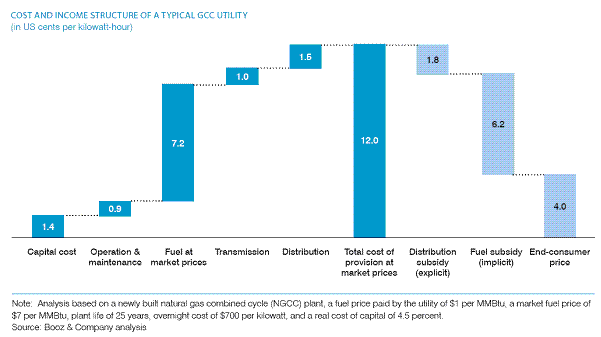

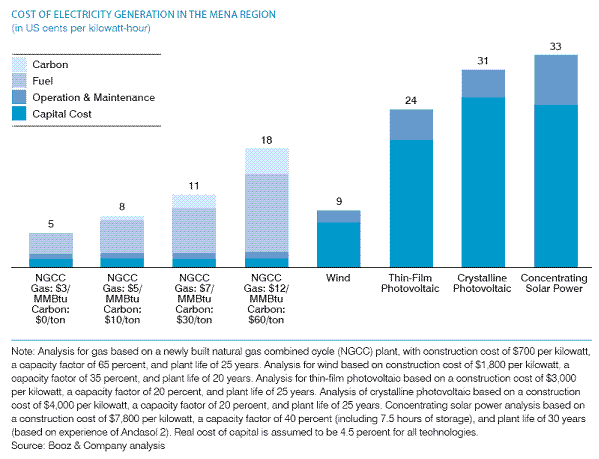
[1] D'Avack, F. (2010, March 25), solar energy analyst, Bloomberg New Energy Finance. (J. Krane, Interviewer). Recent estimates of the installed solar electricity generating capacity in the United States place it at between 1 and 1.7GW. The European Photovoltaic Industry Association in 2010 estimated a 1.65GW PV installation in the US. See: EPIA (May 2010) Global Market Outlook for Photovoltaics until 2014.
[2] Abu Dhabi's natural gas-fired Combined Cycle Generating Turbine plants deliver electricity at a cost near 5 U.S. cents per kilowatt-hour. In comparison, long-term levelized costs of solar power range from 15.4 cents/kWh for photovoltaic solar, to around 25-30 cents/kWh for concentrating solar power. Cost estimates explained in depth elsewhere.
[3] Abu Dhabi's nuclear reactors are expected to produce power at a long-term levelized cost somewhere under 9 cents per kWh.
[4]
"Abu Dhabi Commits to 7 % Renewable Energy Target by 2020," (18 January 2009) UAE government news agency WAM.
http://www.wam.org.ae/servlet/Satellite?c=WamLocEnews&cid=1226858088034&p=1135099400124&pagename=WAM/WamLocEnews/W-T-LEN-FullNews".
Note that Bloomberg News quoted Masdar CEO Sultan al-Jaber in 2012 as identifying the target date for the renewables installation as 2030, rather than 2020. See: "Abu Dhabi pushes back green energy goal to 2030" (17 January 2012) Bloomberg. Bruce Smith, an official from Abu Dhabi Water and Electricity Authority said at a conference in Abu Dhabi on 7 March 2012 that the Bloomberg story was incorrect and that Abu Dhabi's target date remained 2020. Smith noted, however, that ADWEA had not yet been asked by the government to begin contracting for renewable power.
[5] UAE Yearbook: Oil and Gas. (2009). Abu Dhabi: National Media Council.
[6] BP. (2011). BP Statistical Review of World Energy June 2011. London: BP.
[7] Worldwide Fund for Nature. (2008). Living Planet Report 2008. http://www.panda.org/about_our_earth/all_publications/living_planet_report/lpr_2008/.
[8] Depledge, J. (2006). The Opposite of Learning: Ossification in the Climate Change Regime. Global Environmental Politics, pp. 1-22.
[9] "Masdar set to capitalise on international adoption of renewable energy." (19 January 2009). Masdar press release. Accessed 27 March 2010: http://www.masdaruae.com/en/mediaCenter/newsDesc.aspx?News_ID=58&fst=mc&nws=1
[10] Masdar plans wind turbine project, new solar plant. (2011, 10 January) Bloomberg News. [Retrieved 28 February 2012: http://www.arabianbusiness.com/masdar-plans-wind-turbine-project-new-solar-plant--372640.html] See also: Stanton, C. (2009, October 22). Dust a factor in best solar power option for emirate. The National.
[11] "Renewable Energy in Europe: Share of renewable energies in gross electrical consumption in European Union countries in 2007." (undated). EU Energy Portal. Accessed 24 March 2010: http://www.energy.eu/#renewable
[12] International Energy Agency. (2009). CO2 Emissions from Fuel Combustion. Paris: International Energy Agency. See also: Stanton, C. (2010, April 24). A powerful argument for change. The National; http://www.thenational.ae/apps/pbcs.dll/article?AID=/20100424/BUSINESS/704249948&SearchID=73390575210777.
[13] The rising cost of additional production or imports of natural gas renders nuclear power more competitive in Abu Dhabi. A government official told the author in 2010 that, at a gas price of roughly $7 per million BTUs, UAE nuclear and gas generation appear to approach parity.
[14] Economist Intelligence Unit. (February 2012) Country Report: United Arab Emirates. London: Economist Intelligence Unit.
[15] Krane, J. (2009). City of Gold: Dubai and the Dream of Capitalism. New York: St. Martin's Press; p. 253.
[16] Dubai's 1,450 square kilometres under development figure is from Executive Office planner Abdulla al-Nedhar's personal assistant, Iman, in telephone interview Sept. 8, 2008. The figure includes uninhabited land cleared or identified for development; The 2000 U.S. Census lists Houston's city limits as 580 square miles (1,502 sq. km.) with nearly 2 million inhabitants, not including suburbs. See: Krane, 2009; p. 119.
[17] Country Report: United Arab Emirates. (February, 2012). London: Economist Intelligence Unit.
[18] Miller, K., ADWEC planning director. (2008). ADWEC Water and Electricity Demand Forecasts 2008-2030, conference presentation slides; citing Urban Planning Council, Plan Abu Dhabi 2030.
[19] There are competing estimates of the size of the UAE population. A government survey put the 2009 population at 8.19 million. The conservative estimates in this paper come from the Economist Intelligence Unit. (February 2012). Country Report: The United Arab Emirates. London: The Economist Intelligence Unit.
[20] BP, 2011
[21] Abu Dhabi Electricity and Water Co. (2011) Statistical Report 1998-2010. (Abu Dhabi: ADWEC). [Accessed 28 Feb. 12: http://www.adwec.ae/Report2010.html]
[22] Miller, K. (6 Feb. 2012) ADWEC Winter 2011/2012 Electricity and Water Demand Forecasts. Presentation at MEED Power and Water Conference, Abu Dhabi. See also: Stanton, C. (2010, April 24). Abu Dhabi to crack down on energy use. The National; http://www.thenational.ae/apps/pbcs.dll/article?AID=/20100424/BUSINESS/704249906&SearchID=73390575639013.
[23] Abu Dhabi electricity planner, (12 March 2012) interview with author, Abu Dhabi.
[24] Abu Dhabi Regulation and Supervision Bureau. (2009). Consumption Report: Water and Electricity. Abu Dhabi: Abu Dhabi Regulation and Supervision Bureau. Note that there was wide differential between UAE nationals, who consumed an average of 71,000 kWh/year; and expatriates, at 26,500 kWh/year.
[25] Stanton, A powerful argument for change, 2010
[26] International Energy Agency. (2009). CO2 Emissions from Fuel Combustion. Paris: International Energy Agency. See also: Stanton, A powerful argument for change, 2010.
[27] Ledwith, Laura. (Sustainability and Policy Advisor, Emirates Wildlife Society), e-mail interview with author, December 30, 2009. For ecological footprint ranking, see (Worldwide Fund for Nature, 2008)
[28] Capacity factor refers to the ratio of actual power output over time, versus its potential output at full capacity.
[29] Patlitzianas, K., Doukas, H., & Psarras, J. (2006). Enhancing renewable energy in the Arab states of the Gulf: Constraints and efforts. Energy Policy, 3719-3726.
[30] Using typical calculation of $1/million Btu = $5.80/barrel. See: Natural Gas Units & Conversion Table, natgas.info: http://www.natgas.info/html/natgasunitsconversion.html
[31] El Sayed, T., El-Husseini, I., Fayad, W., & Zywietz, D. (2009). A New Source of Power: The Potential for Renewable Energy in the MENA Region. Abu Dhabi: Booz & Co, pp. 14-15.
[32] UAE nationals pay 5 fils per kWh, or 3 fils in remote areas, which works out to 1.4 US cents or .8 US cents per kWh. Source: Abu Dhabi Regulation and Supervision Bureau (Undated) "Information Tariffs." http://www.rsb.gov.ae/En/PrimaryMenu/index.aspx?SubCatMenu_Name=Information%20Publications&SubCatMenu_ID=116&CatMenu_ID=58&PriMenu_ID=114&CatMenu_Name=Publications&PriMenu_Name=Publications
[33] El Sayed, El-Husseini, Fayad, & Zywietz, 2009; p. 15.
[34] See Rentier State Theory literature on the Gulf states: Beblawi, H. (1987). "The rentier state in the Arab world," in Hazem Beblawi and Giacomo Luciani (eds.), The Rentier State (London: Croon Helm). Luciani, G. (1990). "Allocation vs. production states: A theoretical framework," in Giacomo Luciani (ed.), The Arab State (London: Routledge). For a perspective on Abu Dhabi itself, see: Davidson, C.M. (2009). Abu Dhabi: Oil and Beyond. (London: Hurst).
[35] Mehrara, M. (2007). Energy consumption and economic growth: The case of oil exporting countries. Energy Policy, 2939-2945.
[36] El Sayed, El-Husseini, Fayad, & Zywietz, 2009
[37] Mills, R. (2012). Sunrise in the Desert: Solar becomes commercially viable in MENA. (Dubai: Emirates Solar Industry Association and PwC)
[38] Surek, T. (2002). PROGRESS IN U.S. PHOTOVOLTAICS: LOOKING BACK 30 YEARS AND LOOKING AHEAD 20. National Renewable Energy Laboratory, 1-6.
[39] El Sayed, El-Husseini, Fayad, & Zywietz, 2009
[40] Carter, N., director-general of Abu Dhabi Regulation and Supervision Bureau, the emirate's electricity regulator, quoted in: Stanton, C. (2010, June 9). Green subsidy for solar power. The National; http://www.thenational.ae/apps/pbcs.dll/article?AID=/20100609/BUSINESS/706099928/1053
[41] CSP typically allows for some thermal storage that could be effective in covering the evening peak.
[42] Stanton, C. (2010, January 21). Masdar's solar panel plant seeks policy jolt. The National. Note that crystalline PV experienced degrading of 22% of its effectiveness in Abu Dhabi's summer conditions.
[43] Stanton, C. (2009, October 22). Dust a factor in best solar power option for emirate. The National.
[44] Hegazy, A. A. (2001). Effect of dust accumulation on solar transmittance through glass covers of plate-type collectors. Renewable Energy , 525-540. The study describes varying degrees of efficiency loss from dust, depending on weather, placement angle of panels, and frequency of cleaning.
[45] Khurram Nawab, managing director of Mulk Renewable Energy, quoted in Stromsta, K.E. (1 June 2010) "United Arab Emirates has unrealistic solar targets, says Mulk." Recharge. http://www.rechargenews.com/energy/solar/article216410.ece
[46] Stanton, C. (28 March 2010) Author interview, via email.
[47] Global Concentrating Solar Power Potential (map). "Annual Sum of Direct Normal Irradiation [kWh/m2a] for the year 2002." (2002). Deutsches Zentrum für Luft- und Raumfahrt (DLR). http://www.dlr.de/tt/Portaldata/41/Resources/dokumente/institut/system/projects/MED-CSP_DNI_2002.jpg
[48] Germany was responsible for 35% of global PV installation in 2008. "Global Solar Photovoltaic Market Analysis and Forecasts to 2020." PR Log press release. (13 March 2009) Accessed 31 March 2010: http://www.prlog.org/10198293-global-solar-photovoltaic-market-analysis-and-forecasts-to-2020.html
[49] Photovoltaic Solar Resource: United States and Germany (map). (2008) National Renewable Energy Laboratory, U.S. Department of Energy. http://www.seia.org/galleries/default-file/PVMap_USandGermany.pdf
[50] MacKay, D. J. (2009). Sustainable Energy - without the hot air. Cambridge: UIT.
[51] Patlitzianas, Doukas, & Psarras, 2006
[52] Kazmi, A. (2009, July 6). Abu Dhabi perfect for wind farming. Gulf News; http://gulfnews.com/news/gulf/uae/environment/abu-dhabi-perfect-for-wind-farming-1.491002
[53] Alnaser, W. E., & Alnaser, N. W. (2009). Solar and wind energy potential in GCC countries and some related projects. Journal of Renewable and Sustainable Energy, 1-28.
[54] Kauefler, J. (2007). Umwelt Dienstleistungen: Win-Win Potenziale und Exportchancen fur Deutsche Unternehmen - Wind Power Application in Abu Dhabi (UAE). Berlin: SYNLIFT Systems; See slides at: http://www.umwelt-dienstleistungen.de/vortraege/AG1_5_Joachim_Kaeufler.pdf
[55] 4C Offshore. (2010). Global Wind Speed Rankings. Retrieved June 22, 2010, from Global Offshore Wind Farms Database: http://www.4coffshore.com/windfarms/windspeeds.aspx; The lowest average wind speed of nearly 600 wind farms the site cited is 5.54 m/sec, at an Italian installation in the Gulf of Trieste.
[56] 4C Offshore, 2010
[57] Renewable Energy Research Laboratory, University of Massachusetts at Amherst. (undated; retrieved 22 June 2010). Wind Power: Capacity Factor, Intermittency, and what happens when the wind doesn't blow? Amherst: Renewable Energy Research Laboratory, University of Massachusetts at Amherst.
[58] Smith, Bruce. (7 March 2012) Business advisor, Abu Dhabi Water and Electricity Authority. Remarks during MEED Power and Water conference, Abu Dhabi.
[59] Darwish, M.A. (2011) Prospect of using alternative energy for power and desalted water productions in Kuwait. Desalination and Water Treatment. 36; 219-238.
[60] Kumar, H.M. (28 Oct. 2007). Phase one of Masdar City to be ready before 2010. Gulf News. Website accessed 24 March 2010: http://gulfnews.com/business/construction/phase-one-of-masdar-city-to-be-ready-before-2010-1.119793
[61] The Oil Daily. (2011, Jan. 14) "BP and local partner shelve hydrogen power project in Abu Dhabi." [Retrieved 1 March 2012: http://goliath.ecnext.com/coms2/gi_0199-14267987/BP-and-local-partner-shelve.html] See also: Hydrogen Power Abu Dhabi (HPAD). (undated). Hydrogen Power Abu Dhabi. Retrieved May 13, 2010, from HydrogenEnergy.com: http://www.hydrogenenergy.com/details.aspx
[62] Gimbel, B. (2007, March 12). The richest city in the world. Fortune. http://money.cnn.com/magazines/fortune/fortune_archive/2007/03/19/8402357/
[63] According to rankings in the CIA World Factbook.
[64] See, for example: Davidson, C. M. (2005). The United Arab Emirates: A Study in Survival. (Boulder: Lynne Rienner). Exploration of the concept of Gulf Arab countries as allocative rentier states can be found in the works of Giacomo Luciani, Hazem Beblawi and Gregory Gause. Global rentier literature includes the works of Terry Lynn Karl, Kiren Aziz Chaudhry, Dirk Vandewalle and others. Davidson has focussed on Abu Dhabi and the UAE.
[65] See, for example, p. 119 and p. 82 in Gause, F. G. (1994). Oil Monarchies: Domestic and Security Challenges in the Arab Gulf States. New York, Council on Foreign Relations. Also, see p. 327 in Nonneman, G. (2005). Determinants and Patterns of Saudi Foreign Policy: 'Omnibalancing' and 'Relative Autonomy' in Multiple Environments. Saudi Arabia in the Balance. London, Hurst & Co.: 315-351. Also see p. 301 and 309 in Okrhulik, G. (1999). "Rentier Wealth, Unruly Law, and the Rise of Opposition: The Political Economy of Oil States." Comparative Politics: 295-315.
[66] See: Karl, T. L. (1997). The paradox of plenty: Oil booms and petro-states. Berkeley: University of California Press; and Vandewalle, D. (1998). Libya since independence: Oil and state building. Ithaca: Cornell University Press.
[67] Hertog, S. (2010). Princes, Brokers, and Bureaucrats: Oil and the State in Saudi Arabia. Ithaca: Cornell University Press.
[68] The Dubai Electricity and Water Authority raised electricity tariffs on all customers by 15% in January 2011. The rate increase contributed to a 6% drop in electricity consumption that year, according to a DEWA official interviewed by the author in Jan. 2011.
[69] Luomi, M. (2009). Abu Dhabi's Alternative-Energy Initiatives: Seizing Climate-Change Opportunities. Middle East Policy, 16 (4), 102-117.
[70] Davidson, C. M. (2009). Abu Dhabi: Oil and Beyond. London: Hurst. See especially pp. 142-143.
[71] BP (2011)
[72] BP (2011)
[73] For background on the GCC gas shortage, see: Lotter, P., & Semonella, R. (2008). Arabian Gulf Electricity Industry. Dubai: Moody's Global Corporate Finance. Also see: International Energy Agency. (October 2008). Betwixt Petro-Dollars and Subsidies: Surging Energy Consumption in the Middle East and North Africa States. Paris: International Energy Agency.
[74] BP (2011)
[75] International Energy Agency, October 2008
[76] See analysis in UAE nuclear whitepaper: Government of the United Arab Emirates. (undated). Policy of the United Arab Emirates on the Evaluation and Potential Development of Peaceful Nuclear Energy. Abu Dhabi: Government of the United Arab Emirates.
[77] Bhaskar, S., and others describe the 2017 completion date as overly ambitious.
[78] Abu Dhabi energy official interviewed by the author, March 2012.
[79] Ibid.
[80] Kombargi, R., Sarraf, G., Waterlander, O., & Sastry, A. (2010). Gas Shortage in the GCC: How to Bridge the Gap. Abu Dhabi: Booz & Co.; p. 8.
[81] Abu Dhabi is unlikely to pursue coal because its high carbon emissions conflict with IRENA's mandate. However, Dubai in 2010 announced that it was exploring the potential for a large coal-fired power plant.
[82] ADWEC (2012) Statistical Leaflet 2011
[83] Smith (2012)
[84] Kuwait LNG import price is from Petroleum Economist; (Nov. 2011). Vol. 78 Issue 9, p14-14, 1p
[85] Abu Dhabi energy official interviewed by the author, March 2012.
[86] Mills (2012)
[87] Ali al-Naimi (Saudi minister for petroleum and mineral resources), quoted in: Alsharif, A. (23 Sept. 2009) "KAUST Research to Focus on Solar Energy: Al-Naimi," Reuters, via Arab News. See: http://www.arabnews.com/?page=1§ion=0&article=126682&d=23&m=9&y=2009.
[88] Abu Dhabi Urban Planning Council. (2009). Plan Abu Dhabi 2030: Urban Structure Framework Plan. Abu Dhabi: Abu Dhabi Urban Planning Council.
[89] Luomi (2009)
[90] Luomi (2009)
[91] Hydrogen and nuclear initiatives can, however, be counted against the remaining 23% of Abu Dhabi's 30% low-carbon target.
[92] D'Avack (2010)
[93] Luomi (2009)
[94] Nonneman, G. (2005). Determinants and Patterns of Saudi Foreign Policy: 'Omnibalancing' and 'Relative Autonomy' in Multiple Environments. In P. Aarts, & G. Nonneman, Saudi Arabia in the Balance (pp. 315-351). London: Hurst & Co.
[95] Kuwait and Iran have also set renewable generation targets of 5 % and 2 GW of capacity, respectively. See: "Renewable energy targets around the world." Reuters. (undated) Accessed 25 March 2010 at: http://www.reuters.com/article/idUSTRE60R46320100128.
[96] MacKay (2009)
[97] Stanton, C. (2010, June 9). New solar power plant for Abu Dhabi. The National; http://www.thenational.ae/apps/pbcs.dll/article?AID=/20100609/BUSINESS/706099922/1042.
[98] Masdar - Shams I Concentrating Solar Power Plant (report). (2010). Zawya.com.
[99] Stanton, New solar power plant for Abu Dhabi, 2010
[100] Smith (2012)
[101] Smith (2012)
[102] Yee, A. (27 April 2011) Masdar plan for $200m pioneering wind farm. The National.
[103] UAE renewable energy analyst, author interview, (March 23, 2010). Information provided on condition of anonymity.
[104] U.S. Department of Energy press releases. (28 Feb. 2011) "U.S. Department of Energy and Masdar Collaborate In Testing Cutting-Edge Solar PV Coating Technologies." [See: http://energy.gov/articles/us-department-energy-and-masdar-collaborate-testing-cutting-edge-solar-pv-coating] and (26 April 2010) "U.S. and UAE Sign Agreement to Strengthen Cooperation on Clean Energy." [See: http://energy.gov/articles/us-and-uae-sign-agreement-strengthen-cooperation-clean-energy]
[105] A Scottish Government press release carries most details on the agreement. See: "Renewables Research Partnership." (17 Jan. 2012) Scottish Government news release. [http://www.scotland.gov.uk/News/Releases/2012/01/Madsar17012012]
[106] Masdar. (undated) "Our units: Masdar Capital." See: http://www.masdar.ae/en/Menu/index.aspx?MenuID=48&CatID=78&mnu=Cat
[107] Masdar. (17 Jan. 2010) "Press releases: Masdar Begins Research And Development Phase For New Solar Tower 'Beam Down' Facility." See: http://www.masdar.ae/en/mediaCenter/newsDesc.aspx?News_ID=132&fst=mc&nws=1
[108] Hamdan, Sara. (25 Jan. 2012) "United Arab Emirates Promotes Alternative Energy." New York Times. See: http://www.nytimes.com/2012/01/26/world/middleeast/26iht-m26-masdar-invest.html
[109] Patlitzianas, Doukas, & Psarras, 2006
[110] Del Rio, P., & Unruh, G. (2005). Overcoming the lock-out of renewable energy technologies in Spain: The cases of wind and solar electricity. Renewable and Sustainable Energy Reviews , 1498-1513.
[111] Del Rio & Unruh, 2005
[112] El Sayed, El-Husseini, Fayad, & Zywietz, 2009
[113] Roodenrys, G., manager of policy and communications, BP Hydrogen Power Middle East. (24 March 2010). Telephone interview with author.
[114] El Sayed, El-Husseini, Fayad, & Zywietz, 2009
[115] Moves toward these recommendations have already been made. Sultan al-Jaber, Masdar chief executive, was reported in an Abu Dhabi newspaper as having been appointed to the new position of Assistant Foreign Minister and Special Envoy on Energy and Climate Change, and given oversight of a newly created Directorate of Energy and Climate Change within the Ministry of Foreign Affairs. The directorate appears on the Ministry's Web site and lists its director as Thani Ahmad Al Zeyoudi, however little public information on its activities is available. See: Stanton, C. (25 Feb. 2010) "UAE takes lead on climate accord" The National.
[116] Also requiring updating are laws governing the UAE's other three utility authorities, DEWA in Dubai, SEWA in Sharjah, and FEWA, which supplies power to Ajman, Umm Al-Quwain, Ras Al-Khaimah and Fujairah, under Abu Dhabi's support.
[117] Government of Abu Dhabi. (1998, March 1). THE GOVERNMENT OF ABU DHABI PRIVATISATION COMMITTEE WATER AND ELECTRICITY SECTOR. LAW No (2) CONCERNING THE REGULATION OF THE WATER AND ELECTRICITY SECTOR. Abu Dhabi, UAE: Government of Abu Dhabi.
[118] The portfolio standard could also mandate further purchases from other, comparatively expensive sources, such as nuclear or hydrogen-based electricity. This would allow ADWEC to comply with the emirate's "aspirational target" of 30% of generating capacity from low-carbon sources.
[119] Abu Dhabi Regulation and Supervision Bureau, 2010
[120] Smith (2012). See also: Del Rio & Unruh, 2005
[121] Stanton, Green subsidy for solar power, 2010
[122] Abu Dhabi Regulation and Supervision Bureau (1 Feb. 2012) "Request for proposal: Economic advice on calculating cost-reflective tariffs."
[123] The Executive Affairs Authority is a high-level advisory body that provides advice to Sheikh Mohammed bin Zayed, who chairs the Executive Council. The Authority oversees strategic research into economic policy issues ahead of decision-making. See: http://eaa.abudhabi.ae
[124] The DSM Committee is made up of Abu Dhabi's electricity and water generating, transmission, distribution, and regulating authorities, as well as its environment agency, a wildlife group and others. See: http://eaa.abudhabi.ae/Sites/EAA/Navigation/EN/AdvisoryUnits/economic-affairs.html
[125] UAE renewable energy analyst, author interview. (23 March 2010).
[126] See the "Heroes of the UAE" campaign: http://www.heroesoftheuae.ae/en
[127] UAE renewable energy analyst, author interview. (23 March 2010).
[128] Abu Dhabi Regulation and Supervision Bureau, 2010
[129] Abu Dhabi Regulation and Supervision Bureau, 2010
JIME Center.All rights reserved.